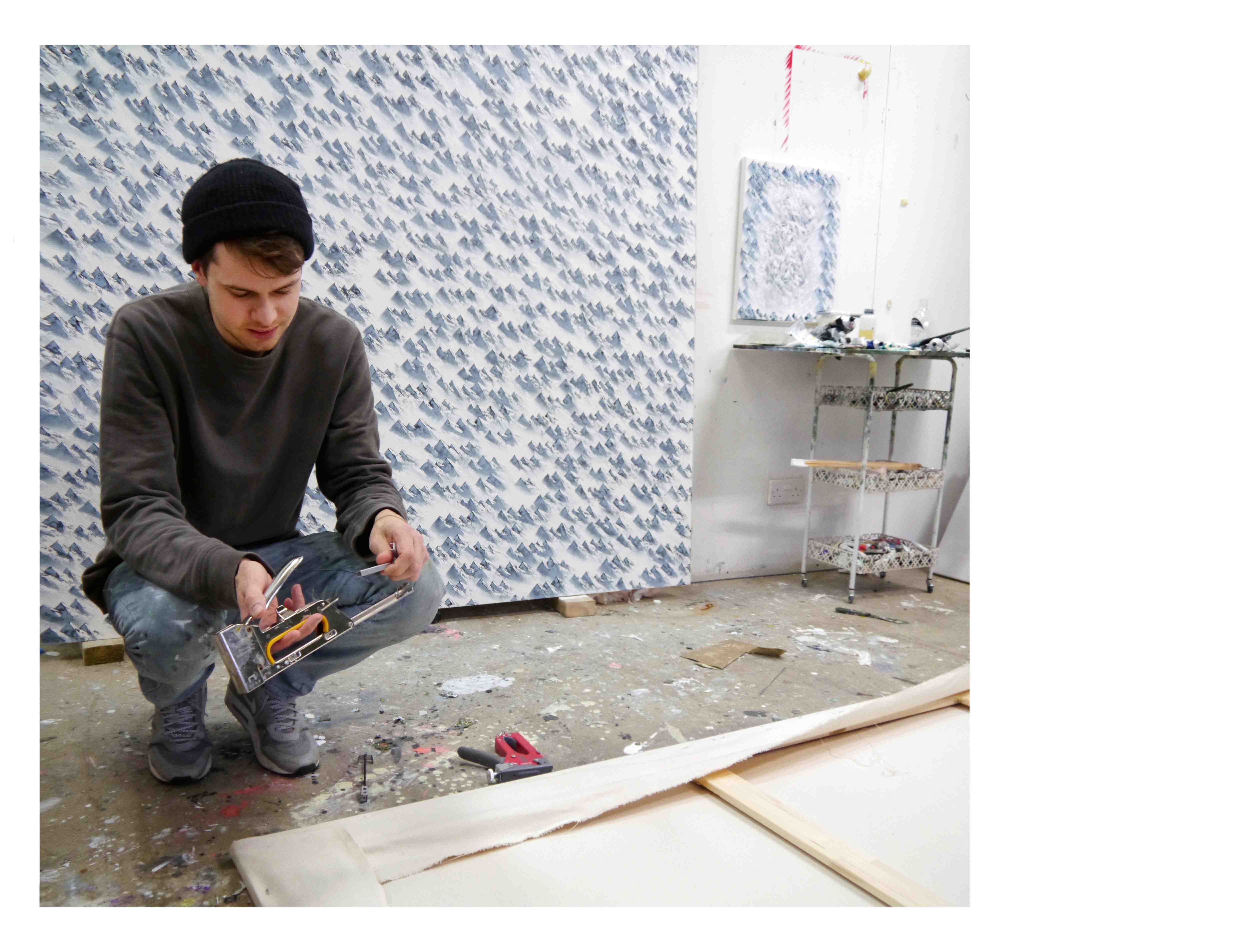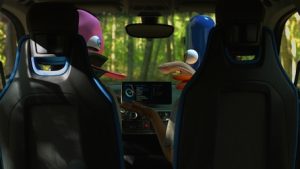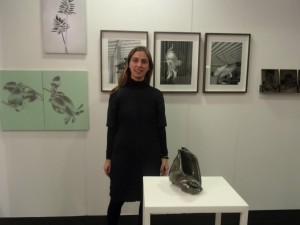
Over the last couple of weeks FAD has been featuring interviews and Q & A’s with the seven shortlisted artists from the prestigious Catlin Art Prize 2014 finally we have the last interview number seven with Neil Raitt from The Royal College of Art, interviewed by Harriet Thorpe.
Neil Raitt is a British contemporary artist based in London. Raitt graduated from an MA in Painting at the RCA in 2013 and his work has since featured in group shows at Hus Gallery in London and Dallas Contemporary, Texas. Surrounded by multiple visions of landscapes, I sat with Raitt in his studio to discuss his work for the Catlin art prize 2014. His works feature repetitive and mesmerizing landscape motifs which follow a democratic formula and an unregulated pattern, achievable to all, but layered with the integrity of an artist.
HT: Can you describe the pieces which you are working on for the Catlin Prize?
NR: I started making this particular series in the last year of my MA at the RCA last year, so it’s been quite an intensive study of an idea. It’s the first time I have worked on a series and it really came out of my interest in making figurative paintings. It was a natural progression to exploring the territory between figuration and abstraction and the conversations that came out during the course with friends and other painters of the idea of the “surface” and how that operates. It became a balancing of tension between those two ideas, drawing the viewer in and at the same time leaving the viewer on the surface.
HT: What kind of figurative works were you doing before?
NR: It was traditionally figurative in that I worked with characters and narrative. I did these forest scenes of these hippies which were derived from photographs and personal travel documentation of different parts of London. I then weaved them into the painting process, blurring the lines between photography and painting. This series comes from ideas that run parallel to that and more specifically this 1980s television programme called The Joy of Painting. I grew up watching it on the Discovery channel and the God channel. It was a programme about how to paint landscapes in half an hour. The aesthetic was really specific and I was thinking about how that approach to painting, the ultimate accessibility, weaves its way into a conversation of a painting that would be interesting in the context of contemporary art. It became a game of blurring lines between high art and something very kitsch.
HT: I’m imagining a paint by numbers! It’s almost like a formula.
NR: That’s an interesting point, because the formula is why I chose to do it; it’s so tied up as a process. I wanted to explore the fragmentation and the deconstructed language. And, what do we identify as good contemporary art? That’s my job I guess. I think every artists job in one way or another is adding something to the conversation that they feel is lacking. I don’t want to destroy the history of The Joy of Painting, because it’s not something that I take in a derogatory sense. It’s a critique and it’s more of an intuitive process, a conceptual process. I would like to take that idea and reconsider the approach. It’s craft and that’s a contentious subject from a contemporary art perspective. My experience on the MA course was really interesting because it really made it clear how separate those two things are. I don’t have that background of contemporary art or traditional art to much extent, I guess my background is my own interest in the craft of painting and drawing. It was a real game of catch up.
HT: So how far did you follow the techniques used by Bob Ross in The Joy of Painting?
NR: I really followed them to the tee, it’s a practice in appropriation as well. I get the books from the internet, I even get them for Christmas! I started doing these paintings and then my girlfriend bought me two books for Christmas. I’m working loosely with Hus gallery and they want to do an installation to recreate the whole TV set! It’s like I’ve created a monster!
HT: You add a lot of your own work to this formula though, like the repetition, where did that idea come from?
NR: The repetition is obviously quite an important part, which takes it away from straight forward trees and landscape painting. It was a way as an image maker to deal with that problem. I started directly painting the landscapes from the television programme on by BA, so at that point it was still in a process of development. It’s naturally come to a head with this series and now I feel comfortable calling them my own.
HT: What about the colours?
NR: The fade, that would be a step in one of the paintings, you would start one of the landscapes by laying down a blue that would fade into a red, then working on top of it. So the forest might get darker towards the bottom and the fade would be a part of that. That was the starting point, then it became something more. At the RCA, there are particular phrases and ideas that get banded around and one of them was the “contemporary fade”. That’s another thing I find interesting, the juxtaposition between this recognisable idea of contemporary art and that highly concentrated colour that blends really smoothly, which is one of the things you associate with it. It’s like finding two things that are almost paradoxical and working with them on a singular piece. There’s aesthetic and formal decisions that play a big part in it and that’s what’s fun for me; exploring postmodernism as a pick and mix kind of idea. There’s elements of art history that I can pick and play with and that keeps the idea developing.
This is going to be a triptych, but it plays on some of the painters who were operating around Post-war contemporary art and the real hard edge Abstract painters. I’m still learning and still interested in exploring them with my own work and stealing some of their ideas, placing them within these very recognisable images of mountains. It’s almost like an archetype of a mountain and it functions in a way that it’s over descriptive and almost prescriptive. Then that takes you somewhere to Northern European Romanticism, so there’s a number of elements at play.
HT: What do you think the Romantic landscape painters would think about your work?!
NR: I do think about that sometimes, if Caspar David Friedrich was around today, what would he do… I think they would think my work was rubbish and lazy! They would say, what tools do you have? The internet. Through which you can access any image in the world any time you want. Just because they did so much with so little, it’s impossible to live up to that.
HT: Do you ever go outside and paint?
NR: I haven’t recently, but I have done plein air painting. I did a residency in Amsterdam when I finished my BA, I don’t know how relevant it is, but I did some portrait paintings of prostitutes in the windows at night. It was a real challenge dealing with people, the pimps in specific, it was a tricky one… I won an art school prize and part of it was a 3 month residency. I was 20 and the idea of a residency was amazing, but the reality kicked in that I was in a youth hostel for 3 months. I did study portraiture as a way into painting, but it was more of a fun idea; I met this guy from Poland who was passing through, and we became friends for that week. It was 3am, we had had a few beers and I got my easel, he gave me a hand and we trekked down to the red light district. I had to approach and knock on the window to ask to paint them, they said no, then we came to an agreement that I would give her the painting in exchange. I have no documentation of it, but she gave me a cushion to sit on and people were coming by and dropping money. It’s always going to be better, that nostalgia of what it was.
HT: Can you describe about the process behind your work for the Catlin Prize?
NR: I lay down a layer of a mixture, its called magic white in Bob Ross world, it’s a mixture of linseed oil and titanium white. The technique is called wet on wet. You lay down a whole coat of oil and then it’s a very straightforward process in may ways; it starts at the top and ends at the bottom.
The process itself becomes a game of plotting land, avoiding it building up into pattern and breaking that down. Each peak overlaps the next one so it has this effect of falling down and it remains somewhere between random and patternistic. It’s important to find that balance. When I’m working it’s easy for the pattern to become very linear, a lot of it is about avoiding that. I work in elements that sit within the piece, so there are these smiley faces, I plot about a handful. It just happened, it’s not really a smiley face, but just little breaks.
HT: Each motif is really individual.
NR: It’s become a very internal process now I’ve worked out how the composition sits. The original landscape is of five peaks, but I plot maybe three, four or five peaks. If you broke it down into a graph you would see that some of them curve up and some of them curve under. They slowly evolve and that’s what maintains my interest.
HT: How will your work for the Catlin Prize be exhibited in the gallery?
NR: Well, I just received this magic tree which I had cut from foam and I’m making a paint out of pine oil and pigment so I have this forest scent. The idea is that its going to hang from the ceiling. The ceiling of the space is quite interesting because there’s so many pipes and ducts. It’s quite industrial and really high. It’s a way to punctuate the space between large painting and large painting, but also a way to add to another part of the process; the element of theatre. It will hang in front of the paintings, far enough away to be an object in its own right, but also eluding to the idea of being in a car and travelling. The triptych will have the loose shape of a windscreen, to have this idea that you’re in a massive car.
It’s a real experiment with the paint. The pine oil is really strong and quite medicinal. I know that the ingredients are very neutral so it should mix. I like the performative aspect of it – the exhibition will run for 30 days and by the end the freshener will have depleted.
HT: The tree and the scent are both condensed and simplified versions of their original form.
NR: It’s almost like a trompe-l’œil, having this illusion that something is happening, a trick. I always think artists are a bit like magicians. It can be an interesting trick or a rubbish trick, but a lot of the artists I’m interested in really draw those tricks out. It’s the idea of a cliché that’s interesting to me. I think artists are always trying to avoid a cliché or think that it’s a derogatory term, but you’re missing a trick taking that approach. The fun is in allowing those criticisms to really manifest in your own work. My work is really rich in that reference and I’m interested to develop that in my own hand and my own language. It will be a case of blurring those lines a bit more.
About The Catlin Art Prize
The Catlin Art Prize gives talented young artists who have recently graduated from UK art schools the opportunity to showcase their work professionally and win a significant monetary award towards their future development.
Graduating artists from around the UK are visited and assessed by Art Catlin curator, Justin Hammond, and 40 are invited to feature in The Catlin Guide, an exclusive publication showcasing the most promising new artists in the country.
From the Guide, a small number of artists are selected as finalists for the Prize and are invited to demonstrate their progress by presenting a new body of work at the Catlin Art Prize exhibition, held 12 months on from graduation.
Finalist selection is based on the standard of their work and their potential to make a significant mark in the art world over the course of their early careers.
During the exhibition an independent panel of judges including Turner Prize winner Mark Wallinger will select a winner who will receive the £5,000 prize. A visitor vote is also held, allowing the general public to vote for their favourite artist via the website and at the exhibition. The winner of which will receive £2,000.
From the 2014 Guide seven artists have been invited to demonstrate their progress by presenting a new body of work at the Catlin Art Prize exhibition, held 2nd -24th May 2014 More Details: www.artcatlin.com









